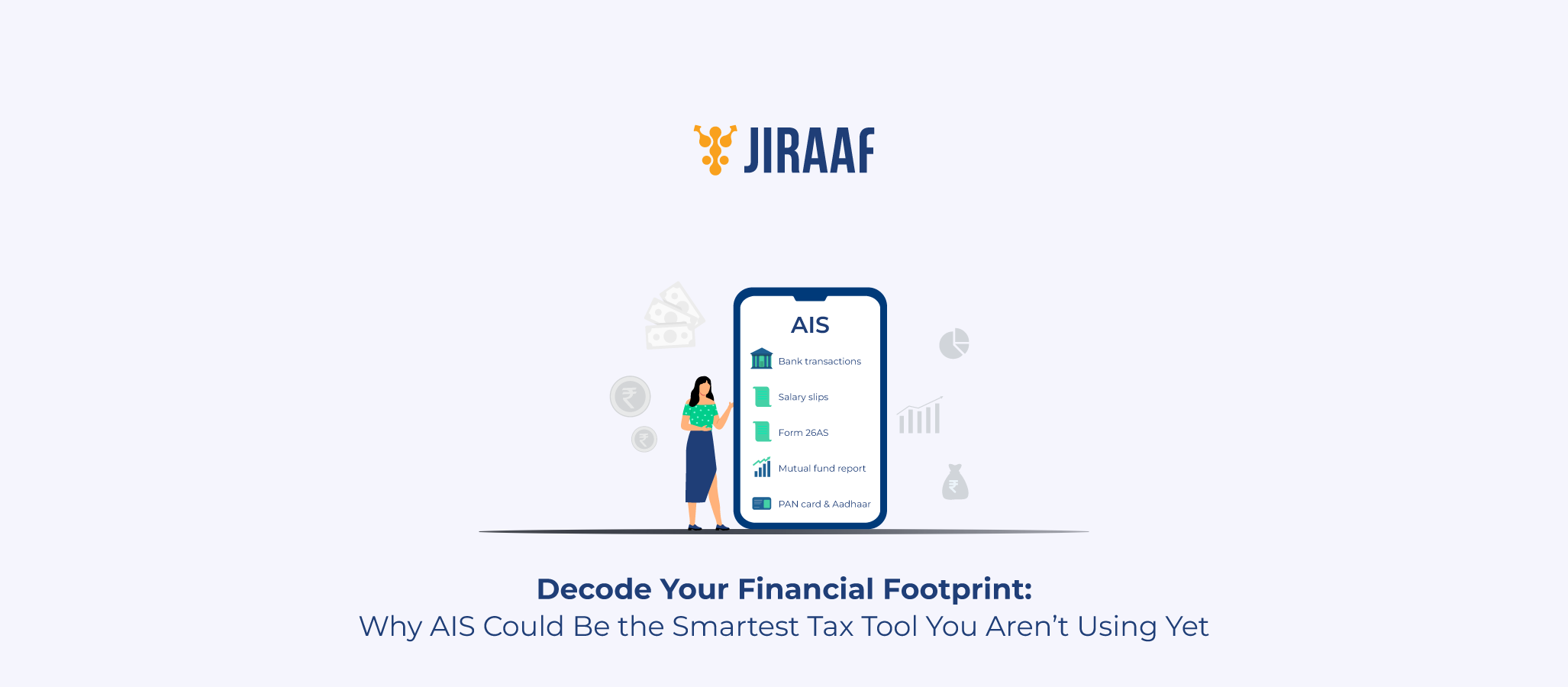When it comes to filing your income tax return (ITR), you’re probably used to looking at your Form 26AS. But what if we told you there’s another statement—far more detailed—that gives you a 360-degree view of your financial transactions?
Enter the Annual Information Statement (AIS)—a comprehensive tool introduced by the Income Tax Department to give you better visibility and control over your tax-related data.
In this blog, you’ll get a complete overview of AIS, how it works, why it matters, and how you can make it your secret weapon for accurate tax filing.
What Is AIS in Income Tax?
AIS is a relatively new initiative by the Income Tax Department of India. It acts like a consolidated digital report card that records most of your financial transactions from different sources.
It was introduced as part of the government’s effort to increase transparency, curb tax evasion, and make tax filing smoother and more accurate for you.
Purpose of AIS
The main purpose of AIS is to
- Provide a consolidated view of your income and financial transactions.
- Help you cross-verify your declared income with third-party information.
- Reduce the risk of under-reporting or misreporting income.
- Give early insights into any discrepancies you might need to fix before filing your ITR.
In short, AIS helps you avoid unpleasant surprises and notices from the tax department.
What Information Does AIS Include?
Unlike Form 26AS, which only shows Tax Deducted at Source (TDS) and a few other elements, AIS digs deeper.
Think of it as a financial magnifying glass that scans across different sectors and sources to track your income, investments, and spending patterns.
Key Components of AIS
Here’s what you’ll typically find in your AIS:
- TDS/TCS Details
Just like Form 26AS, AIS captures tax deducted or collected at source on your income.
- Interest Income
All types of interest—on savings accounts, fixed deposits, recurring deposits—are captured via reporting from banks and NBFCs.
- Dividend Income
If you’ve received dividends from mutual funds or stocks, it’s in there.
- Sale/Purchase of Securities and Mutual Funds
Stock trades, mutual fund redemptions, etc., as reported by depositories like NSDL and CDSL.
- Income from Business or Profession (in some cases)
Especially if you’re dealing in contracts or TDS is deducted on professional services.
- Rent Received
If your tenant deducts TDS on rent payments, it will reflect here.
- Foreign Remittances
Any money sent or received from abroad via official channels.
- High-Value Transactions
Such as large cash deposits, credit card spends, property purchases, and more.
- Refund Information
If you received a refund from the Income Tax Department in the previous years.
- Other Income
Like lottery winnings, commissions, etc., if reported by third parties.
Each entry in the AIS is tagged with a source and status—whether it’s accepted or if you’ve provided feedback.
How to Access AIS on the Income Tax Portal
Getting your AIS is super simple. Here’s a step-by-step guide:
- Visit the Income Tax Portal at https://www.incometax.gov.in.
- Login using your PAN and password.
- Go to ‘Services’ > ‘Annual Information Statement (AIS)’.
- You’ll be redirected to the AIS portal.
- Click on ‘AIS’ to view or download the PDF or JSON file.
- Optionally, check the Taxpayer Information Summary (TIS)—a condensed version of the AIS meant to simplify things.
Pro tip: Always cross-check your AIS and Form 26AS before filing your ITR.
AIS vs Form 26AS
While both AIS and Form 26AS aim to help you file your taxes correctly, they’re not the same.
Here’s a side-by-side comparison of what each of them provides and what it does not:
| Feature | Form 26AS | AIS |
| Scope | Limited | Comprehensive |
| Shows TDS/TCS | Yes | Yes |
| Includes Interest/Dividends | No | Yes |
| Securities Transactions | No | Yes |
| High-Value Transactions | No | Yes |
| Property/Foreign Remits | No | Yes |
| Summary View Available | No | Yes (TIS—Taxpayer Info Summary) |
| Feedback Option | No | Yes |
So, while Form 26AS is still useful, AIS is clearly the more complete picture.
Why AIS Matters for Taxpayers
- Avoid Tax Notices
If your ITR doesn’t match what’s reported in AIS, you could get flagged.
- Catch Missed Income
Sometimes, banks or companies might report something you forgot—interest, dividends, rent, etc.
- Validate Third-Party Reporting
AIS helps ensure what others are reporting about your income is actually accurate.
- Improve Financial Awareness
You’ll get a clearer idea of your income flow and spending patterns.
- Ease of Filing ITR
With TIS, you can get a summarized version of your earnings, helping you file your return faster.
AIS basically acts as a mirror between your financial world and the tax department. You want the reflections to match.
Common Errors in AIS and How to Correct Them
Even though AIS is compiled using data reported by third parties, it’s not always error-free. Here are some common issues and what you can do:
1. Incorrect Income Reporting
Your bank might report higher interest than you actually earned.
Solution: Submit feedback directly in the AIS portal under the specific transaction.
2. Duplicate Entries
Sometimes, dividends or TDS entries may appear more than once.
Solution: Flag them as duplicate while giving feedback.
3. Wrong PAN Linking
A transaction might show up in your AIS because the other party entered your PAN incorrectly.
Solution: Submit feedback or raise a grievance.
4. Mismatched TDS
The TDS amount in AIS may not match your payslip or actual deduction.
Solution: Confirm with your employer or deductor and ask for a revised TDS return.
5. Unrecognized Transactions
You might see a transaction that doesn’t belong to you at all.
Solution: Mark it as “Information is incorrect” with reason and evidence.
The key takeaway? Don’t blindly trust your AIS. Review it, respond, and raise objections if needed.
Final Thoughts: AIS as a Powerful Tax Filing Tool
Think of AIS as your personal tax intelligence dashboard—pulling data from multiple financial sources and offering you a bird’s-eye view of your income.
It makes tax filing easier, reduces errors, and increases transparency. But more than that, it empowers you to take charge of your finances.
As AIS evolves, it’s likely to become the go-to document for salaried individuals, investors, and business owners alike. It won’t replace Form 26AS just yet, but it’s certainly paving the way forward.
So next time you sit down to file your ITR, don’t just look at your salary slips—open your AIS, and let it guide you.
FAQs
What is AIS in income tax?
AIS (Annual Information Statement) is a detailed report introduced by the Income Tax Department that consolidates your financial transactions—like interest, dividends, securities, and high-value purchases—for a given financial year.
How is AIS different from Form 26AS?
Form 26AS only covers TDS/TCS and limited info, whereas AIS gives a full picture of your income sources, investments, and high-value transactions.
Is AIS mandatory for filing ITR?
It’s not mandatory, but reviewing your AIS before filing ITR helps avoid errors and mismatches, reducing the risk of scrutiny or notices.
What if my AIS has incorrect details?
You can log into the AIS portal and submit feedback against each incorrect entry, marking it as inaccurate or not related to you.
Do salaried individuals need to check AIS?
Yes, especially if you earn interest, dividends, or have mutual fund transactions. AIS helps ensure your ITR reflects all reportable income.
Discover fixed income investments with Jiraaf, a SEBI registered online bonds platform that educates and brings access to a wide array of bonds. Sign up today to explore diversified fixed income investment opportunities to support your goal-based wealth creation journey. Start investing!



